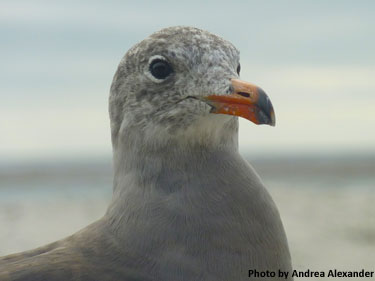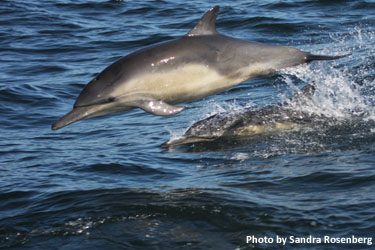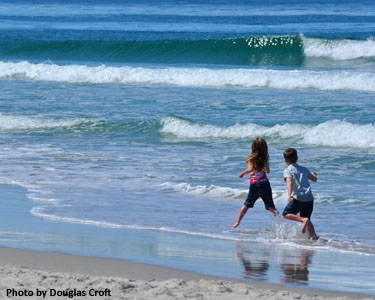RELATED PAGES: Let's Make Trash Extinct! | Coastal Cleanup Day | Adopt-A-Beach® | Schoolyard Cleanup Program

Marine debris, as defined by the federal government, is any persistent solid material that is manufactured or processed and directly or indirectly, intentionally or unintentionally, disposed of or abandoned into the marine environment or the Great Lakes. Essentially it is any trash or litter that ends up in a marine (saltwater) environment or the Great Lakes. It originates from a wide variety of locations and can travel great distances before ending up in the ocean. Marine debris is everywhere—it is found around every major body of water on the planet and along every shoreline in the world, no matter how remote. Marine debris is a global pollution problem that impacts human health and safety, endangers wildlife and aquatic habitats, and costs local and national economies millions in cleanup costs, wasted resources, and lost revenues.
Many people assume that if trash exists in the ocean, it must be that the fishing and shipping industries are to blame. But in fact, only an estimated 20% of the items found in the ocean can be linked to ocean-based sources, like commercial fishing vessels, cargo ships (discharge of containers and garbage), or cruise ships.
The sheer amount of plastic that is currently produced has overwhelmed our existing waste management systems, and as a result, plastic escapes from many different sources, such as litter (from pedestrians, motorists, beach visitors), industrial discharges (often in the form of plastic pellets and powders), and disposal (open trash cans, overflowing landfills, etc). The problem is exacerbated by the sheer volume of waste that is being created. In 2016, the United States generated more plastic waste that any county in the world, with a total of 42 million metric tons. However, the United States only has 4.3% of the world's population (World Bank 2021). U.S. per capita plastic waste generation is 130 kg/year, which is about 2-8 times higher than many other countries.
There is growing research about plastic debris too small to be caught by existing water treatment systems. This debris may take the form of synthetic fibers from clothing or other items that are laundered. A 2015 study in San Francisco Bay found that eight waste water treatment plants discharged an average of 490,000 particles of microplastic per day into the Bay.
California residents and tourists love our coast and ocean, making more than 150 million visits to California beaches each year. The effort to keep our shorelines clear of marine debris comes at a significant cost. A 2012 study determined that 90 west coast communities spend a total of more than $520,000,000 each year to combat litter. In 2014, the United Nations' estimate of the global economic impact from plastic pollution to fishing, tourism, and shipping reached, at a minimum, $13 billion annually.
In 1975, the National Academy of Sciences estimated that ocean-based sources, such as cargo ships and cruise liners, dumped 14 billion pounds of garbage into the ocean. In 1988, the U.S. signed onto MARPOL Annex V, joining 64 other countries that signed the international protocol that regulates ocean dumping and made it illegal to dump plastic into the ocean. Even so, plastic pollution is a major problem. A 2001 study found an average of 334,271 pieces of plastic per square mile in the North Pacific Central Gyre (sometimes referred to as the Great Pacific Garbage Patch), which serves as a natural eddy system to concentrate material. A 2015 paper analyzing multiple research studies estimated between 15 to 51 trillion particles of floating microplastic (defined as smaller than 200 mm) are in the world's ocean, weighing between 93 and 236 thousand metric tonnes. In 2015, a team of researchers estimated that the mass of land-based macroplastic waste (larger than 5 mm) entering the world's oceans in 2010 averaged 8.4 million metric tonnes (18.5 billion pounds) per year, with an additional 1.5 million metric tons of primary microplastic (smaller than 5 mm) entering the world's oceans as well. If current rates of plastic production and waste generation continue, the cumulative mass of ocean plastic could increase by ten times the 2010 levels by 2025. All this debris in the marine environment means hazards for animals and humans. A 2020 review of 747 separate studies found documented cases of entanglement or ingestion by marine animals in 914 species. This includes all known sea turtle species and about half of all of marine mammal species. More than 80% of these impacts were associated with plastic debris.

Entanglement
Common items like fishing line, strapping bands and six-pack rings can hamper the mobility of marine animals and cause injury. Once entangled, animals have trouble eating, breathing or swimming, all of which can have fatal results. Plastics do not biodegrade and may continue to trap and kill animals year after year. In 2016, the Secretariat of the Convention on Biological Diversity reported that marine debris entanglements had been documented for 519 species of animals, an increase of 136 species from 2012, including 46% of all species of marine mammals.
Ingestion
Birds, fish and mammals can mistake plastic for food. Debris may cause choking and injuries, and with plastic filling their stomachs, animals may have a false feeling of being full and may die of starvation. Sea turtles mistake plastic bags for jellyfish, one of their favorite foods. Ingestion of debris has been documented in 56% of cetacean species, including whales. A 2013 study of harbor seals in the Netherlands found that more than 12% had plastic in their digestive system. 95% of Northern Fulmars studied in the North Sea between 2007 and 2011 were found to contain plastic, on an average 0.38 grams. This could equal as much as 8.4% of the bird's body weight.
The Laysan albatross is a sea bird that nests in the Northwest Hawaiian Islands. The adult birds collect plastic debris (along with food) from the ocean to feed to their chicks. In a study of dead chicks during 1994 and 1995, 97.6% of carcasses were found to contain plastic. (View a powerful short video filmed at Midway Atoll National Wildlife Refuge.)
Disruption of Habitat
Floating marine debris can provide a new and increased method of transport for species across vast ocean distances, which may cause trouble for biodiversity if the introduced species prove to be invasive. A 2002 study of 30 remote islands throughout the world showed that marine debris more than doubled the "rafting" opportunities for species. In 2005 and 2006, surveys of marine debris in the Seychelles Islands showed that on some beaches more than 60% of debris items carried non-native species.
Marine debris is not just an issue for the surface of the ocean. Debris is also found on the deep ocean floor. An extensive survey extending down to 4,000 meters off the coast of Monterey found that debris was more common in the deeper parts of Monterey Canyon, below 2,000 feet. Found items included large numbers of plastic bags, as well as metal cans, fishing equipment, glass bottles, shoes, and tires. A study of microplastics in Monterey Bay found particles widespread throughout the water column depth range, with the highest concentration between 200 and 600 meters deep.
Marine debris can present a danger to human health. Nails, glass, and syringes on the beach
can cause physical harm to beach-goers. Additionally, trash in our waterways increases the amount of
pathogens and harmful chemicals, impacting water quality.

A study of predatory fishes in the North Pacific Subtropical Gyre found that 19% of the individuals contained marine debris, most of it plastic. This included species commonly eaten by people. In fact, microplastics are increasingly found in the human food system, although their impacts on health are difficult to assert and require further research. A 2015 study of fish and shellfish for sale in markets found 28% of individual fish sampled in Indonesia and 25% in California contained human-made items in their digestive tracts. Plastic debris serves to concentrate and transport chemical pollutants into the marine food web, and potentially to human diets. At least 78% of the priority pollutants and 61% of priority substances listed as toxic by the United States EPA and the European Union are associated with plastic debris. Chemicals of concern include those used in the manufacture of the plastics, as well as pollutants present in the ocean water absorbed and concentrated in the plastic (and thus made available for animal consumption). A study of fish that consumed plastic that had absorbed chemical pollutants from the marine environment were found to bioaccumulate the chemicals, resulting in greater physical harm than to fish that consumed plastic that had not been exposed to a marine environment.
Marine debris is a hazard to economic health. Fishing line and nets can entangle propellers, causing damage to boats. Unsightly trash on beaches detracts from tourism. The Asia-Pacific Economic Cooperation released a report valuing different marine debris abatement measures and found that the loss of tourism from littered beaches in the APEC region was $622 million/year. The damage to the fishing industry totaled $364 million/year, the damage to the shipping industry was $279 million/year, and the total cost of marine debris in the APEC Region totaled $1.265 billion/year. (The APEC Region does not include California, but an estimate can be drawn from the comparison. The APEC Region has a $207 billion marine economy; California has a $46 billion marine economy.
Plastic is made from crude oil and natural gas, which are fossil fuels. Plastic production, collection, and disposal are major sources of greenhouse gas emissions. (Heat-trapping gases, or "greenhouse" gases, contribute to climate change.) A 2018 study found that greenhouse gases are emitted as plastics degrade when exposed to sunlight in the environment. If plastic production and use grow as currently planned, by 2030 these emissions could reach 1.34 gigatons per year. By 2050, the total greenhouse gas in the atmosphere from plastic alone could reach over 56 gigatons, which is 10-13% of the emissions limit that would keep global temperature rise below 1.5 degrees Celsius.
Use Less Stuff, and Make Careful Consumer Choices
The more trash you create, the greater the potential for marine debris to result. You can start by being a smart shopper. Think before making a purchase. Is the item something that you need? Can you instead use something that you already have? Can you borrow the item or check it out from a lending library? Can you purchase it used from a thrift or consignment shop? Can you find this item for sale with less packaging? Can you purchase it in bulk? If not, is there a good substitute that you can find with less packaging, or with packaging that can be composted or easily recycled (like cardboard or glass)? Can you invest in a reusable item that will replace a disposable item? Is this a durable item that you can reuse over and over, or use for a different purpose once the original use has ended? And as the final choice, is the item and/or its packaging recyclable if it is a disposable item that can not be reused? Learn more ways to "Make Trash Extinct."
Take Action:
Plastic
Almost 90 percent of floating marine debris is plastic. Due to its durability, buoyancy, and ability to accumulate and concentrate toxins present in the ocean, plastic is especially harmful to marine life.
One type of plastic debris found all over the world are plastic pellets, or "nurdles," which are the raw material transported to plastics manufacturing facilities to be melted into products such as disposable forks and bottles, computer monitors, toys, etc. To learn about (and perhaps participate in) a study of these pellets' accumulation of organic pollutants from sea water, visit International Pellet Watch.
Have you heard of the "Pacific Garbage Patch" and want to learn more? Contrary to some reports, it is not a giant floating island of trash in the middle of the Pacific Ocean. It is, however, a major environmental concern. A better analogy than an island is a plastic soup, with debris found throughout the water column. Here are a few links to organizations with information on the problem of plastic pollution in the ocean:
Find a selection of streaming videos about marine debris and plastic pollution, and other topics, on our Educator Resource page.
Photographer Chris Jordan documented his experience of visiting Midway Island with other artists and journalists, and the impact of plastic debris on the Laysan albatross population that nests there. Their Youtube channel has many powerful, short videos.
Looking for images of marine debris that you can use? Find some on the NOAA Marine Debris Program's flickr page.
Reports on the topic of Marine Debris:
Access California Coastal Cleanup Day historical data, including "top ten" lists of debris items, and collection data dating back to 1988.